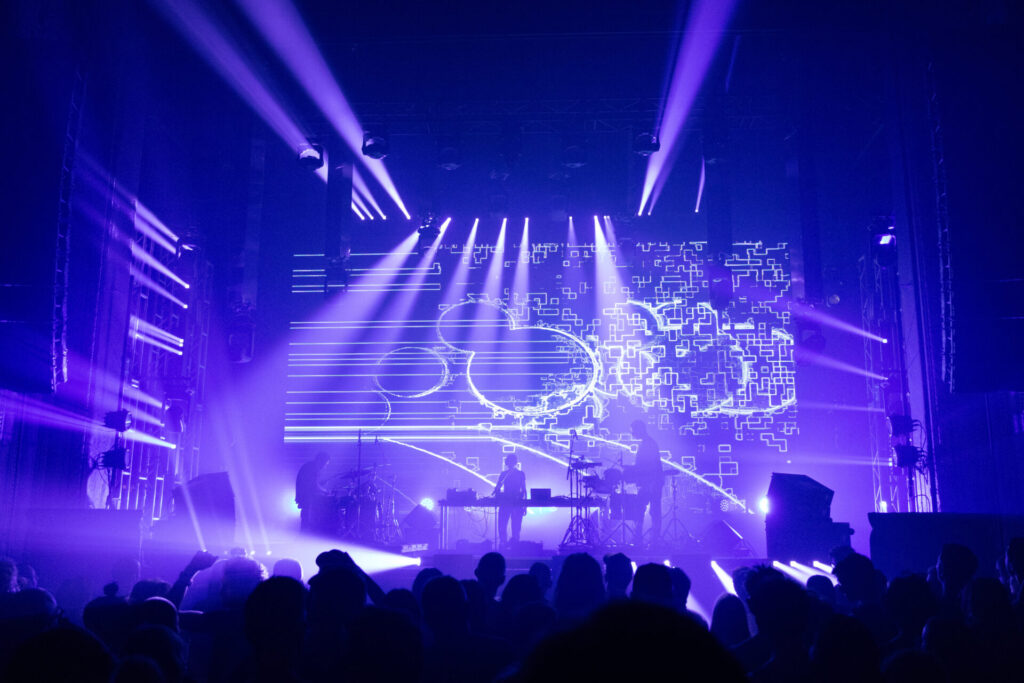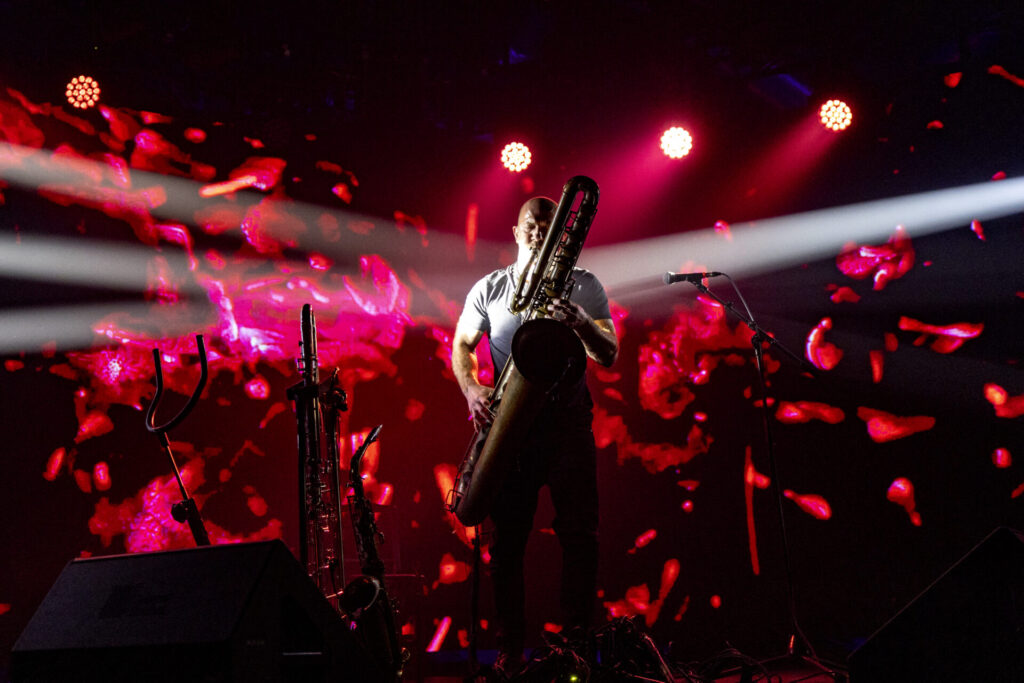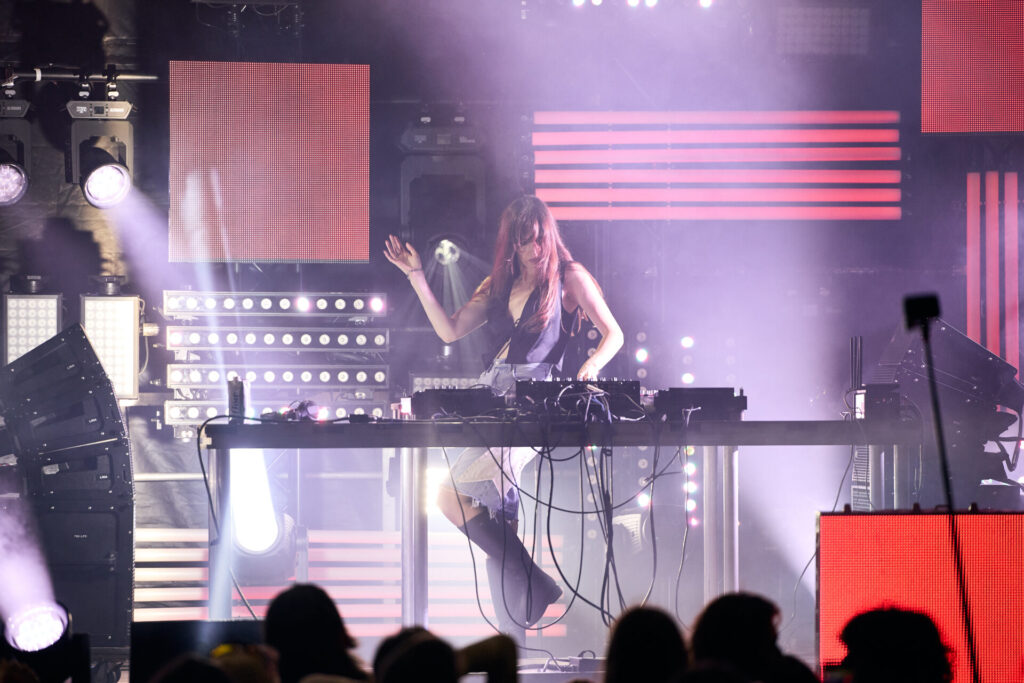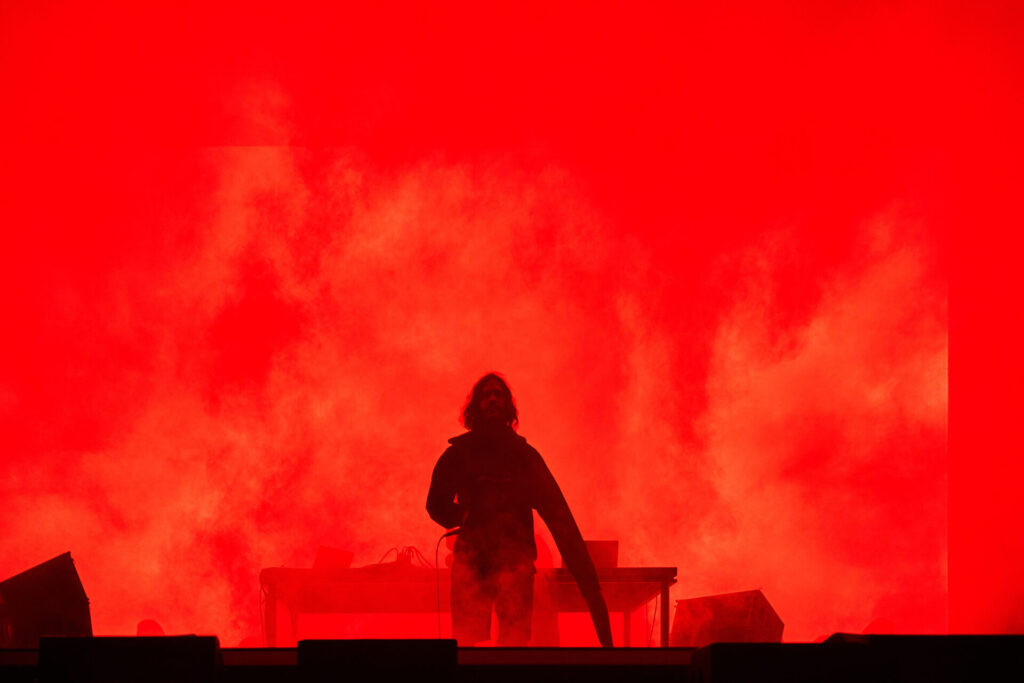“What we can offer is the chance to fall apart on stage,” Nik Colk Void of Factory Floor recently said, in the band’s first interview since announcing their return. It was ahead of their show at MUTEK Montreal, the 25th anniversary of the festival that is “dedicated to the dissemination and development of digital creativity in sound, music, and audio-visual art”. It was intended not as a promise of sabotage or a declaration of incompetence but more of a desire for the band to return to a sonic world that is more unpredictable, interactive, human, and full of such intensity and momentum that it risks being pushed close to collapse.
In reality, Factory Floor come closer to caving in the floor of the stage than they do falling apart on it. Now with added live member Joe Ward, who adds a flurry of percussion from cowbell to electronic drums via bongos, the three of them are already a powerhouse unit. It’s been half a decade since they last played, and then a few years on top of that since Gabe Gurnsey was playing drums in the band (they were a purely electronic duo by the end of the first incarnation). There is an almost symbolic re-introduction of Gurnsey’s drums to the group, as Void builds up a moody, humming, electronic pulse that is entirely absent from any rhythm for about ten minutes. It creates a zone of tension that sits next to anxiety before the inevitable arrival of Gurnsey – initially via teasing hi-hats and sparse kick drums before fully letting rip – and then the pair lock back in seamlessly.
By the time they are back playing old classic ‘Two Different Ways’ it already feels thunderous, as beats and drums collide, with Ward fleshing things out and adding extra depth and complexity, as squelchy electro-techno bounces around the massive theatre, which by now is moving like a club. Some of the new material is lean, taut and groove-locked, recalling touches of 1970s Germany in its hypnotic charge albeit filtered through a touch of ecstasy-induced dancefloor elation and always driven by that distinct sound that is unquestionably theirs. ‘Fall Back’ is stretched out even further than its original eight or so minutes and is – like their entire set – a masterclass in push and pull, tension and release, as that threat of falling apart feels palpable such is the ferocious and unpredictable interplay between humans and machine as they fall into a rhythm that settles into a kind of discordant harmony. It is a joyous and sincerely welcome return and one of those shows that rattles around in your bones for some time afterwards; one you can still hear echoes of pinging around your skull when you wake the following morning.
While Factory Floor unquestionably pull off their return set with exactly the same kind of spirit and throbbing fury they possessed at the beginning of their career, seeing three people go at it with such unrelenting intensity does make one begin to think about the beautiful role that mistakes, accidents, errors or just the occurrence of flat-out implosion can have. Especially during a climate in which the desire to perfect, streamline, replicate, and curate every last detail of the human experience are all such prominent forces and cultural talking points.

Perhaps the earliest potential for some kind of catastrophe can be found on the Esplanade Tranquille, an excellently curated open-air stage that is free to the public all week. However, it has been hammered with rain non-stop for at least a day by the time I arrive. Huge polythene bags are wrapped around mixing desks and equipment recalling the corpse of Laura Palmer, as rain lashes down. Thankfully I do not witness any electrocution take place, just the Canadian producer Sara Magnan, who is performing a world premiere of Rétrocausalité – which is a culmination of seven years of life in Mexico and the sound archives she created in that time. The result is a deep, dark, dubby set often matched with snippets of vocals that resemble crowds cheering, which play out above the grumbling beats. If the ground wasn’t already rippling with rain drops, the bass would likely do that job; while the ominous fog horn-like blasts that ring out feel especially suitable in the weather. In the end Magnan delivers a genuinely stonking set that feels as brooding and engulfing as the thick grey skies that hover above.
Premieres and live debuts make up a big part of the festival, further adding to this feeling of artists gleefully plunging into terrain that holds the potential for the unknown. The likes of Bored Lord, ÈBONY, G L O W Z I C O M B O, and Piezo are all premiering work at the festival, and the killer Brooklyn DJ Ayesha also turns her very physical and rhythmic “body over mind” approach to music into a live show for the first time.
However, given that this is a festival rooted in exploring the intersection of digital creativity across various art forms, AI is also an inescapable presence at the festival. It dominates huge parts of the five day forum section, across a series of panels, masterclasses and keynote speeches. Yves Jacquier, Executive Director of Ubisoft’s La Forge leads a panel on generative AI that addresses the question: “How do we ensure that the technology develops in a way that augments and sustains human creativity?” While TAIT – who have transformed gig concerts by the likes of Rhianna, U2, Beyonce and Coldplay into dazzling immersive spectacles – lead a panel on Using Technology To Place Humans At The Core of Experiences, exploring how their platform is “enhancing audience engagement and creating more interactive, personalised experiences.”
If there is an overarching theme that can be plucked from all of this, it’s asking what does it mean to be a human creative not only in a digital and hyperconnected sphere but one that is increasingly becoming AI-driven and shaped. But in many ways a lot of the live music on display, while still hugely forward looking and innovative, answers this in a brilliantly unique way: fallibility. Sure, some of the music being made here is at the cutting edge of technology, made with some of the most brilliant, expensive, modern equipment going, but it’s the human capacity for error – and subsequent embracing of, and reacting to, said mistakes – that feels like it connects so much throughout this weekend.
The idea of ironing out creases is omnipresent within technological evolutions in art and creativity. The idea of creating systems that can eradicate blips and recreate, or even replicate, the work of humans is something that a lot of artists are grappling with. Generative AI might be at the forefront of a lot of movements in these worlds but it’s also something a percentage of artists appear to be fearful of. A recent report published by the snapilly-tilted Australasian Performing Right Association and Australasian Mechanical Copyright Owners Society (APRA AMCOS) claims that Generative AI could put a substantial amount of musicians’ revenue “at risk” by 2028; and a quarter of those surveyed believed that music creators’ revenue will take a hit due to generative AI within the next four years. The data also predicts an impact of around $350million in losses in the next four years in the music industries of Australia and New Zealand alone.
This isn’t about being technophobic of course, MUTEK is a shining example of a festival that is platforming and showcasing a way to evolve hand-in-hand with all of this in as positive, harmonious and ethical a way as possible. From exploring the overlaps between art and science and the groundbreaking role AI can have there, to displaying 23 digital installations they have set up across the city, it is unquestionably a leading force in this area. However, while much of this conversation may be about a way of presenting pathways that place humans at the centre of this area of rapid growth and expansion, there is also perhaps an underlying inference that it’s also something artists are being forced to negotiate with. That while they can’t push back the tide, they may, if they’re smart enough, figure a way to ride the wave in synchronicity.
When you further factor in the curatorial and algorithmic age that we are currently navigating, in which designing and maximising human experiences seems to be based on anticipating needs, wants and expectations, rather than delivering surprise or bucking trends, it all adds to this inescapable feeling of universal streamlining. Of functionality, precision and predictability over the messy, complicated and unreliable. Not all creases need ironing out. And actually, where MUTEK ends up shining the brightest, perhaps somewhat ironically, is that it’s created a place where the beauty of imperfection in human creativity feels just as innovative and progressive as anything that is coming out of Silicon Valley labs and boardrooms.

There are few artists who encompass the thrill of raw liveness – both on record and on stage – as Colin Stetson. He is dedicated resolutely to capturing the moment as it unfurls in real time. For his solo recordings he lays them down in one-take, with little in the way of processing or overdubbing and this is of course how it is live. On stage as he stands there in the shadows, resembling an almost Elephant Man-like figure with half his head covered by a monumental bass saxophone that recalls a mangled trunk, the noises he creates never cease to be astounding. Like a solo artist and a symphony all at once, it’s a constant head scratcher just what Stetson is doing as it builds and layers and drowns you in a big swirl of engulfing sound. Through his insane circular breathing techniques, Stetson creates a hypnotic sense of rhythm that shifts in waves of intensity, almost recalling the highs of a trip at full peak as the rushes come and go in bursts, remaining both consistent yet also different with each fresh hit.
Within this whirlwind he creates, Stetson lets rip sounds that create a notional dinosaur roar, the deadly purr of the Xenomorph on board the space tug Nostromo, a wail of tortured screams, and occasionally something resembling full-blown armageddon. The latter can especially be heard on new song ‘The Six’, as Stetson unleashes a sound that’s redolent of a fully-staffed steelworks at peak operation during wartime. Its physicality is immense and when pushed through the absolutely pummeling yet immaculate sound system at New City Gas – voted as one of the top 100 clubs in the world by DJ Mag – it is like a dropkick to the gut and head simultaneously. It almost borders on the frightening at points, as if that nice rhythmic, hypnotic trip that Stetson has lulled you into earlier is now showing signs of potentially getting a bit fucking edgy and going sour. Stetson is clearly having a blast though. “I feel very alive,” he giddily pants after finishing that song. “Fuck that’s…” and then he punches the air as if lost for words to describe what he’s just produced. He later exclaims: “It’s really fun being this loud. It’s like being a fire and brimstone evangelist.” The closing ‘The Love It Took To Leave You’, another new one, shows that Stetson is clearly still capable of pushing his practice and instrument into new places. At times he sounds like a one man Sunn O))) and at others like an electronic artist deftly stacking up layers and grooves to subtly build up a set. The irony is not lost on Stetson that he is booked to play an all-out electronic festival while only playing traditional instruments but there’s something beautifully fitting and emblematic about this that right bang at the centre of a festival all about pushing forward with new technologies and exploring AI futures, that one of the most inventive and ground-breaking performers at the whole thing is the closest one to using antiquated tools.
One act who harnesses the power and potential of human error, alongside pushing new technologies to their limits, is Amnesia Scanner and Freeka Tet. They have previously said of their music: “I’m interested in mistakes. I believe that mistakes are the closest thing to what we are. Emulating nice things is very easy but emulating mistakes is very hard. Mistakes are so personal.” Yet they also sit nicely at the intersection between human and AI interaction, while gladly embracing limitations on both ends. The video for their latest track ‘AS Over’ is AI generated and intended to be a “satirical allegory about humans, technology and the eternal loop of excitement, fear and acceptance”. How that all translates live is one big, brilliantly messy, chaotic back and forth that feels like two humans working in sync but also in angry competition, while also pushing their machines to similar extremes. It sounds like all genres at once – at times it’s a riotous mix of noise, metal, R&B and hyperpop thrown into a wood chipper. It’s a thrilling, furious, and at times flat-out cacophonous approach that feels set out to undermine predictability and convention with as much intent as possible.

Another artist who is embracing dualities, albeit different ones, is Montreal’s own Marie Davidson, who merges bouncy electro, thumping techno and a fun approach to live dance music that contains one of the rarest human character traits to usually be found in the genre: humour. Six years on since it was the track of the year in many clubs, ‘Work It’ still pops off. Part earnest declaration of prioritising human experience above the grind, part satirical takedown of hustle culture, and part feel good electro-pop, it is a neat crystallisation of an unavoidable theme of the festival: a human being’s need for forging identity, both personal and sonic, in a landscape and climate that you often feel like you have a struggling grasp of.
Although if there’s one artist that embodies the beauty of human error, who has managed to spin it into a solid identity, it’s Stefan Betke under his Pole alias. The very name of the project is a tribute to a mistake, when he once dropped his Waldorf 4-Pole filter on the floor but then the strange glitchy, hissing sounds that it emitted as a now piece of broken equipment were worked into his process. This sound would go on to be a trademark of sorts, as heard on landmark releases such as the pivotal 1,2,3 trilogy. On the final night of the festival, his performance is wall-rattling stuff, with enough pulverising sub-bass to set off a tsunami of inadvertent bowel movements. It’s intensely dub-heavy but also noisy, static and dense. It’s music that feels like a fog as much as a sound. With perfect, and slightly hilarious synchronicity, the sound cuts dead only a few tracks into his set. His hands go up in the air in puzzlement, as tech hands rush to the stage to fix whatever has gone wrong. Human error or technical failure, who knows. But within a few minutes, the room is vibrating again and, if anything, things become even more intense and – with the response to things going wrong arguably resulting in an enhanced performance.
MUTEK has firmly positioned itself as a world-leading festival when it comes to radical, progressive, innovative uses of digital technology but it’s also an unexpectedly beautiful showcase for how human fallibility can also still drive forward music and performance with equal force. As much as we can now tailor, curate and personalise musical experiences with frightening predictability and accuracy, there’s sometimes no greater thrill than the potential for it all to fall apart.


